Pearson BTEC HND Business Management - Unit 2 Marketing Report: A1
VerifiedAdded on 2022/01/18
|16
|4233
|459
Report
AI Summary
This report, prepared by a student, analyzes marketing concepts, processes, and the 7Ps marketing mix within the context of a BTEC HND in Business Management. The report begins with an introduction to marketing, defining the concept and exploring current and future trends. It delves into different marketing processes, including the marketing process steps. The report then examines the role and responsibilities of a marketing manager, along with the influences and interrelationships between marketing and other functional departments such as finance, HRM, sales, production, and logistics. Furthermore, the report highlights the value and importance of the marketing role within an organization. The analysis includes a comparison of the products of Colgate Palmolive Vietnam and Unilever Vietnam using the 7Ps marketing mix. The report concludes with a summary of key findings and insights into the subject matter.
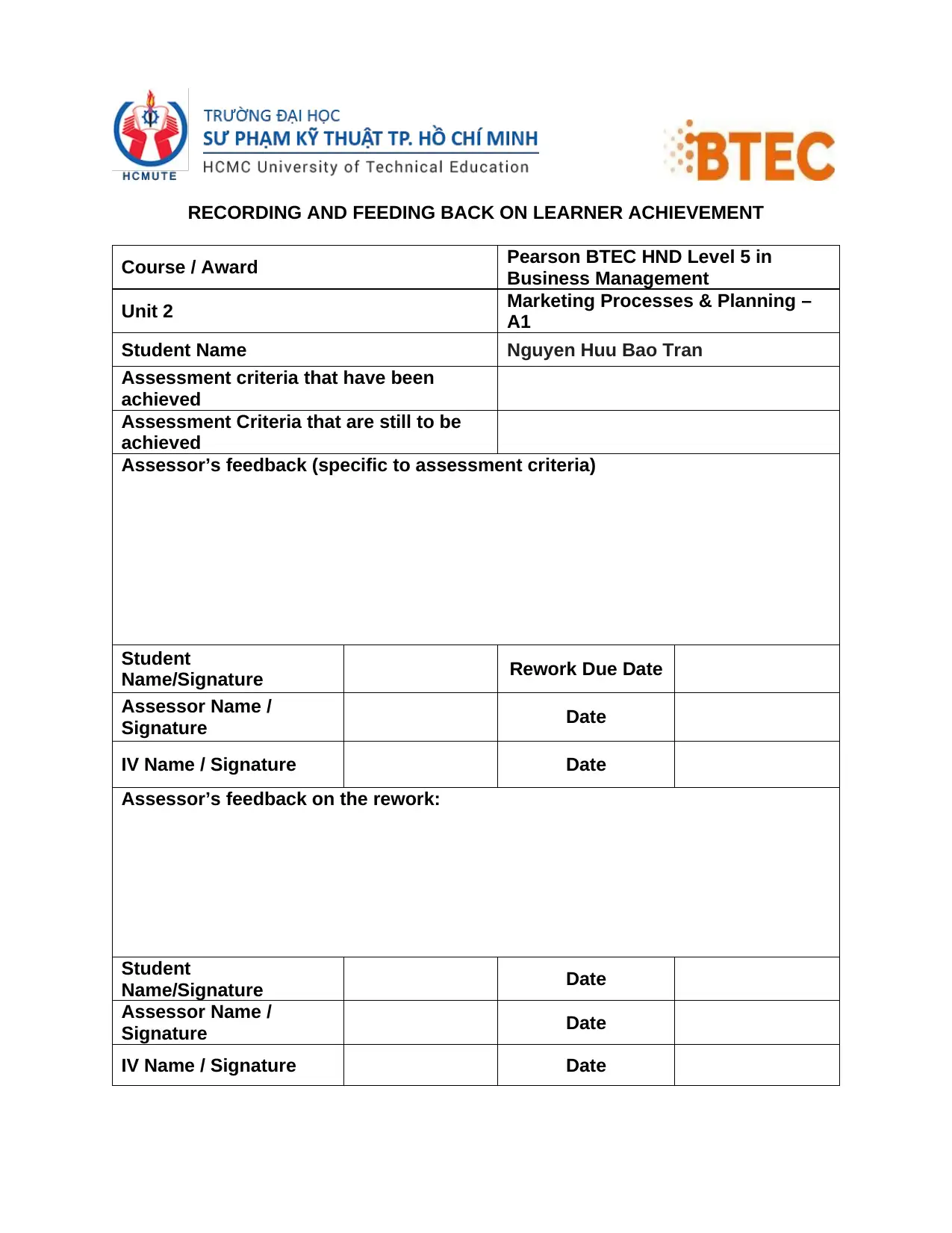
RECORDING AND FEEDING BACK ON LEARNER ACHIEVEMENT
Course / Award Pearson BTEC HND Level 5 in
Business Management
Unit 2 Marketing Processes & Planning –
A1
Student Name Nguyen Huu Bao Tran
Assessment criteria that have been
achieved
Assessment Criteria that are still to be
achieved
Assessor’s feedback (specific to assessment criteria)
Student
Name/Signature Rework Due Date
Assessor Name /
Signature Date
IV Name / Signature Date
Assessor’s feedback on the rework:
Student
Name/Signature Date
Assessor Name /
Signature Date
IV Name / Signature Date
Course / Award Pearson BTEC HND Level 5 in
Business Management
Unit 2 Marketing Processes & Planning –
A1
Student Name Nguyen Huu Bao Tran
Assessment criteria that have been
achieved
Assessment Criteria that are still to be
achieved
Assessor’s feedback (specific to assessment criteria)
Student
Name/Signature Rework Due Date
Assessor Name /
Signature Date
IV Name / Signature Date
Assessor’s feedback on the rework:
Student
Name/Signature Date
Assessor Name /
Signature Date
IV Name / Signature Date
Paraphrase This Document
Need a fresh take? Get an instant paraphrase of this document with our AI Paraphraser
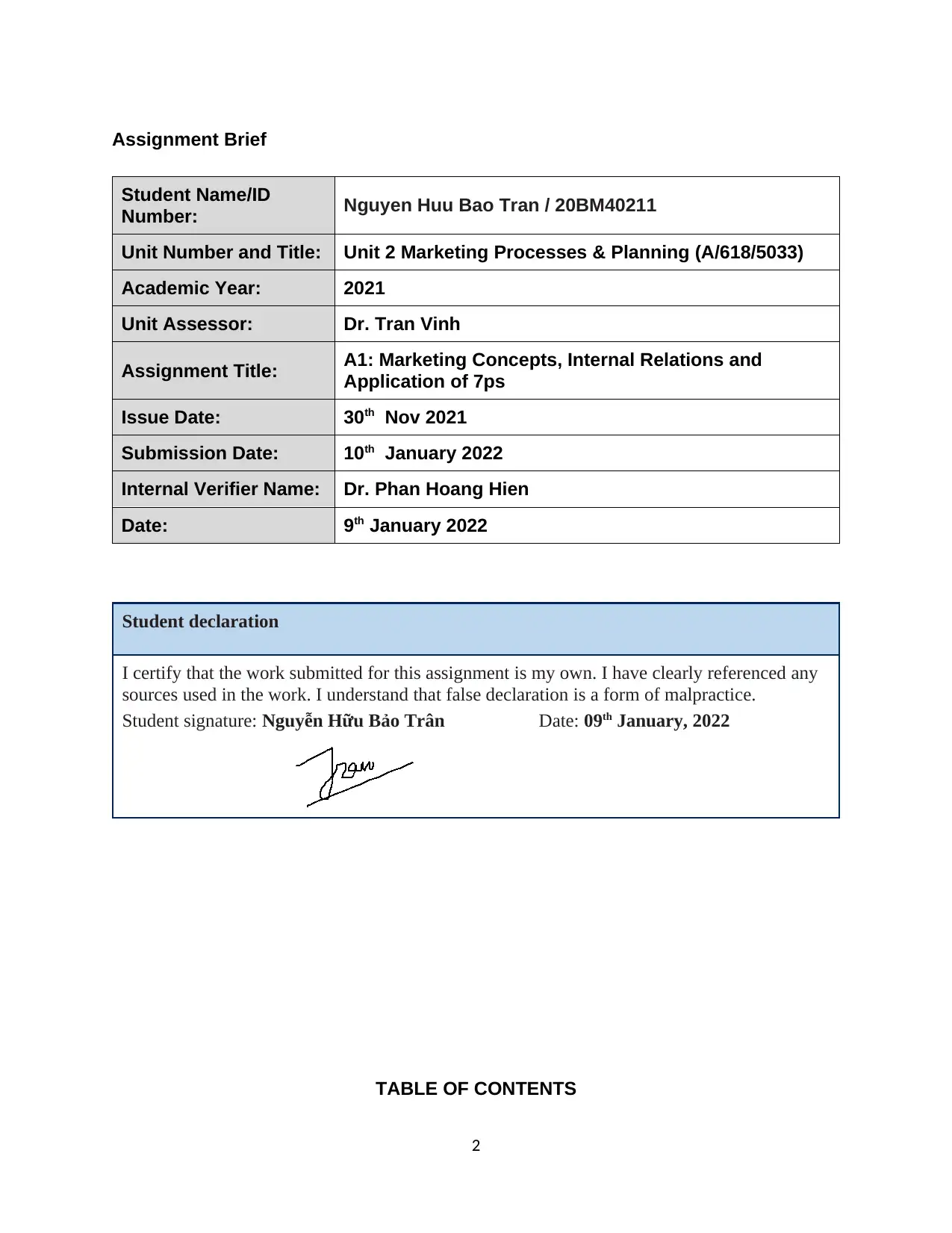
Assignment Brief
Student Name/ID
Number: Nguyen Huu Bao Tran / 20BM40211
Unit Number and Title: Unit 2 Marketing Processes & Planning (A/618/5033)
Academic Year: 2021
Unit Assessor: Dr. Tran Vinh
Assignment Title: A1: Marketing Concepts, Internal Relations and
Application of 7ps
Issue Date: 30th Nov 2021
Submission Date: 10th January 2022
Internal Verifier Name: Dr. Phan Hoang Hien
Date: 9th January 2022
Student declaration
I certify that the work submitted for this assignment is my own. I have clearly referenced any
sources used in the work. I understand that false declaration is a form of malpractice.
Student signature: Nguyễn Hữu Bảo Trân Date: 09th January, 2022
TABLE OF CONTENTS
2
Student Name/ID
Number: Nguyen Huu Bao Tran / 20BM40211
Unit Number and Title: Unit 2 Marketing Processes & Planning (A/618/5033)
Academic Year: 2021
Unit Assessor: Dr. Tran Vinh
Assignment Title: A1: Marketing Concepts, Internal Relations and
Application of 7ps
Issue Date: 30th Nov 2021
Submission Date: 10th January 2022
Internal Verifier Name: Dr. Phan Hoang Hien
Date: 9th January 2022
Student declaration
I certify that the work submitted for this assignment is my own. I have clearly referenced any
sources used in the work. I understand that false declaration is a form of malpractice.
Student signature: Nguyễn Hữu Bảo Trân Date: 09th January, 2022
TABLE OF CONTENTS
2
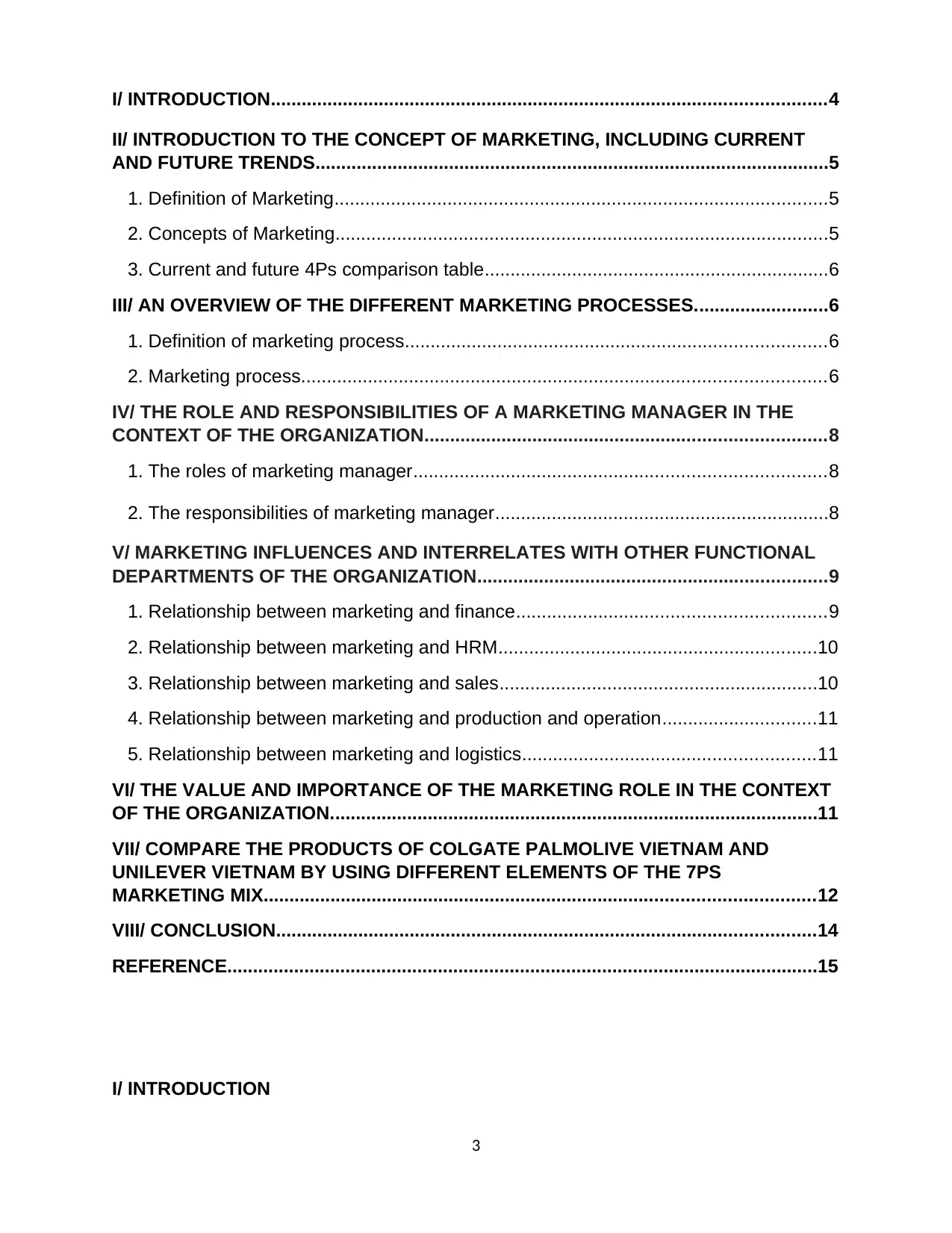
I/ INTRODUCTION............................................................................................................4
II/ INTRODUCTION TO THE CONCEPT OF MARKETING, INCLUDING CURRENT
AND FUTURE TRENDS....................................................................................................5
1. Definition of Marketing................................................................................................5
2. Concepts of Marketing................................................................................................5
3. Current and future 4Ps comparison table...................................................................6
III/ AN OVERVIEW OF THE DIFFERENT MARKETING PROCESSES..........................6
1. Definition of marketing process..................................................................................6
2. Marketing process......................................................................................................6
IV/ THE ROLE AND RESPONSIBILITIES OF A MARKETING MANAGER IN THE
CONTEXT OF THE ORGANIZATION..............................................................................8
1. The roles of marketing manager................................................................................8
2. The responsibilities of marketing manager.................................................................8
V/ MARKETING INFLUENCES AND INTERRELATES WITH OTHER FUNCTIONAL
DEPARTMENTS OF THE ORGANIZATION....................................................................9
1. Relationship between marketing and finance............................................................9
2. Relationship between marketing and HRM..............................................................10
3. Relationship between marketing and sales..............................................................10
4. Relationship between marketing and production and operation..............................11
5. Relationship between marketing and logistics.........................................................11
VI/ THE VALUE AND IMPORTANCE OF THE MARKETING ROLE IN THE CONTEXT
OF THE ORGANIZATION...............................................................................................11
VII/ COMPARE THE PRODUCTS OF COLGATE PALMOLIVE VIETNAM AND
UNILEVER VIETNAM BY USING DIFFERENT ELEMENTS OF THE 7PS
MARKETING MIX...........................................................................................................12
VIII/ CONCLUSION.........................................................................................................14
REFERENCE...................................................................................................................15
I/ INTRODUCTION
3
II/ INTRODUCTION TO THE CONCEPT OF MARKETING, INCLUDING CURRENT
AND FUTURE TRENDS....................................................................................................5
1. Definition of Marketing................................................................................................5
2. Concepts of Marketing................................................................................................5
3. Current and future 4Ps comparison table...................................................................6
III/ AN OVERVIEW OF THE DIFFERENT MARKETING PROCESSES..........................6
1. Definition of marketing process..................................................................................6
2. Marketing process......................................................................................................6
IV/ THE ROLE AND RESPONSIBILITIES OF A MARKETING MANAGER IN THE
CONTEXT OF THE ORGANIZATION..............................................................................8
1. The roles of marketing manager................................................................................8
2. The responsibilities of marketing manager.................................................................8
V/ MARKETING INFLUENCES AND INTERRELATES WITH OTHER FUNCTIONAL
DEPARTMENTS OF THE ORGANIZATION....................................................................9
1. Relationship between marketing and finance............................................................9
2. Relationship between marketing and HRM..............................................................10
3. Relationship between marketing and sales..............................................................10
4. Relationship between marketing and production and operation..............................11
5. Relationship between marketing and logistics.........................................................11
VI/ THE VALUE AND IMPORTANCE OF THE MARKETING ROLE IN THE CONTEXT
OF THE ORGANIZATION...............................................................................................11
VII/ COMPARE THE PRODUCTS OF COLGATE PALMOLIVE VIETNAM AND
UNILEVER VIETNAM BY USING DIFFERENT ELEMENTS OF THE 7PS
MARKETING MIX...........................................................................................................12
VIII/ CONCLUSION.........................................................................................................14
REFERENCE...................................................................................................................15
I/ INTRODUCTION
3
⊘ This is a preview!⊘
Do you want full access?
Subscribe today to unlock all pages.

Trusted by 1+ million students worldwide
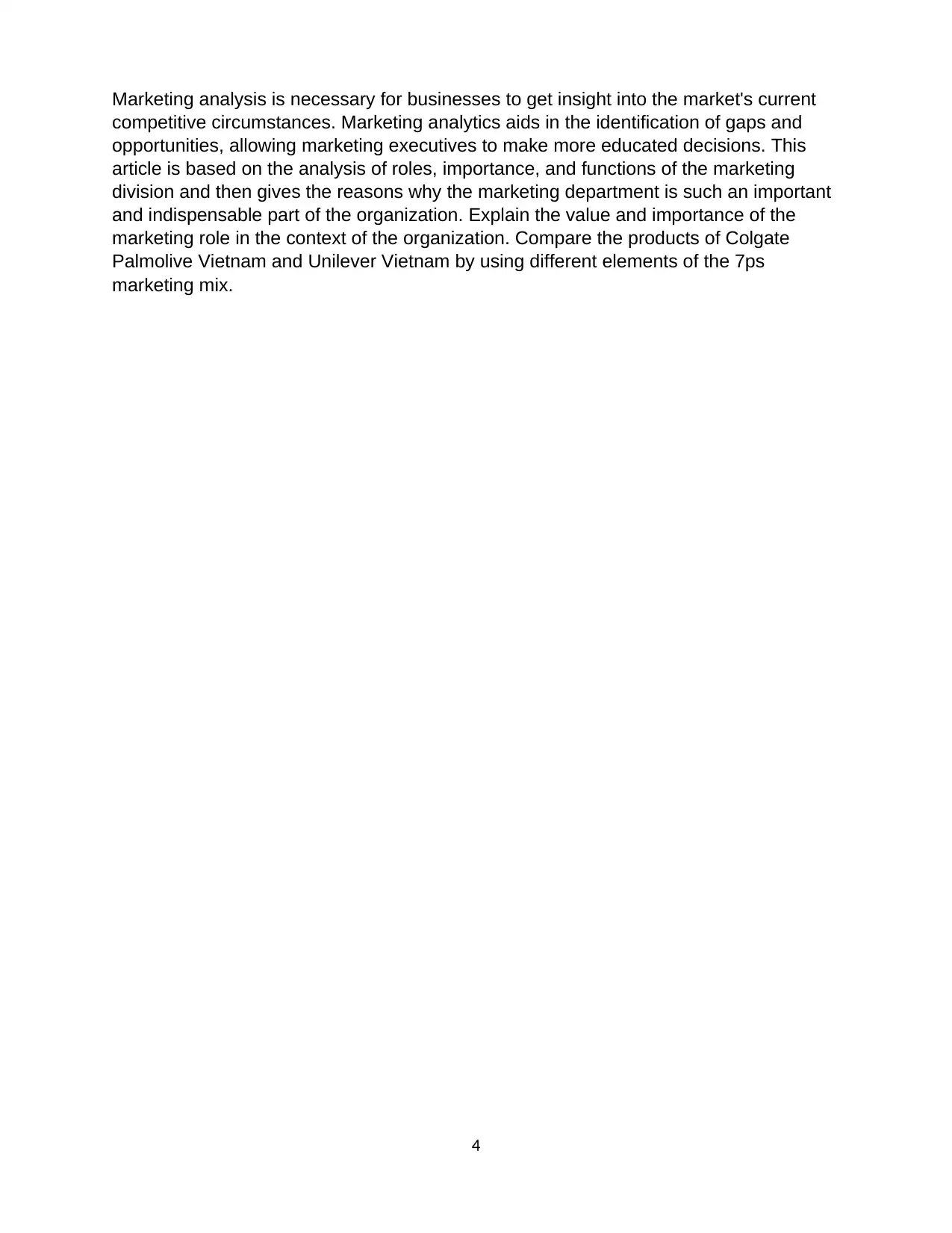
Marketing analysis is necessary for businesses to get insight into the market's current
competitive circumstances. Marketing analytics aids in the identification of gaps and
opportunities, allowing marketing executives to make more educated decisions. This
article is based on the analysis of roles, importance, and functions of the marketing
division and then gives the reasons why the marketing department is such an important
and indispensable part of the organization. Explain the value and importance of the
marketing role in the context of the organization. Compare the products of Colgate
Palmolive Vietnam and Unilever Vietnam by using different elements of the 7ps
marketing mix.
4
competitive circumstances. Marketing analytics aids in the identification of gaps and
opportunities, allowing marketing executives to make more educated decisions. This
article is based on the analysis of roles, importance, and functions of the marketing
division and then gives the reasons why the marketing department is such an important
and indispensable part of the organization. Explain the value and importance of the
marketing role in the context of the organization. Compare the products of Colgate
Palmolive Vietnam and Unilever Vietnam by using different elements of the 7ps
marketing mix.
4
Paraphrase This Document
Need a fresh take? Get an instant paraphrase of this document with our AI Paraphraser
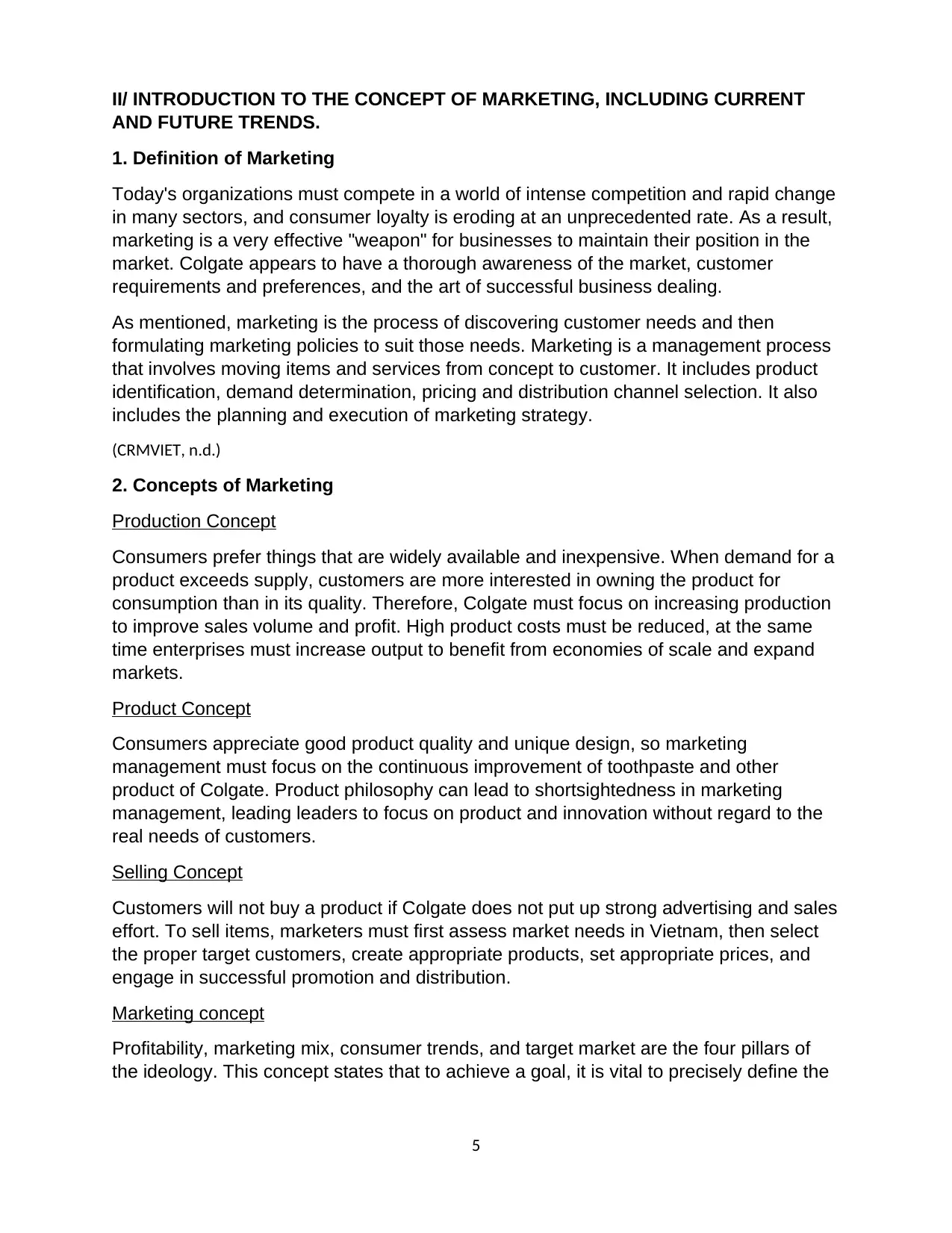
II/ INTRODUCTION TO THE CONCEPT OF MARKETING, INCLUDING CURRENT
AND FUTURE TRENDS.
1. Definition of Marketing
Today's organizations must compete in a world of intense competition and rapid change
in many sectors, and consumer loyalty is eroding at an unprecedented rate. As a result,
marketing is a very effective "weapon" for businesses to maintain their position in the
market. Colgate appears to have a thorough awareness of the market, customer
requirements and preferences, and the art of successful business dealing.
As mentioned, marketing is the process of discovering customer needs and then
formulating marketing policies to suit those needs. Marketing is a management process
that involves moving items and services from concept to customer. It includes product
identification, demand determination, pricing and distribution channel selection. It also
includes the planning and execution of marketing strategy.
(CRMVIET, n.d.)
2. Concepts of Marketing
Production Concept
Consumers prefer things that are widely available and inexpensive. When demand for a
product exceeds supply, customers are more interested in owning the product for
consumption than in its quality. Therefore, Colgate must focus on increasing production
to improve sales volume and profit. High product costs must be reduced, at the same
time enterprises must increase output to benefit from economies of scale and expand
markets.
Product Concept
Consumers appreciate good product quality and unique design, so marketing
management must focus on the continuous improvement of toothpaste and other
product of Colgate. Product philosophy can lead to shortsightedness in marketing
management, leading leaders to focus on product and innovation without regard to the
real needs of customers.
Selling Concept
Customers will not buy a product if Colgate does not put up strong advertising and sales
effort. To sell items, marketers must first assess market needs in Vietnam, then select
the proper target customers, create appropriate products, set appropriate prices, and
engage in successful promotion and distribution.
Marketing concept
Profitability, marketing mix, consumer trends, and target market are the four pillars of
the ideology. This concept states that to achieve a goal, it is vital to precisely define the
5
AND FUTURE TRENDS.
1. Definition of Marketing
Today's organizations must compete in a world of intense competition and rapid change
in many sectors, and consumer loyalty is eroding at an unprecedented rate. As a result,
marketing is a very effective "weapon" for businesses to maintain their position in the
market. Colgate appears to have a thorough awareness of the market, customer
requirements and preferences, and the art of successful business dealing.
As mentioned, marketing is the process of discovering customer needs and then
formulating marketing policies to suit those needs. Marketing is a management process
that involves moving items and services from concept to customer. It includes product
identification, demand determination, pricing and distribution channel selection. It also
includes the planning and execution of marketing strategy.
(CRMVIET, n.d.)
2. Concepts of Marketing
Production Concept
Consumers prefer things that are widely available and inexpensive. When demand for a
product exceeds supply, customers are more interested in owning the product for
consumption than in its quality. Therefore, Colgate must focus on increasing production
to improve sales volume and profit. High product costs must be reduced, at the same
time enterprises must increase output to benefit from economies of scale and expand
markets.
Product Concept
Consumers appreciate good product quality and unique design, so marketing
management must focus on the continuous improvement of toothpaste and other
product of Colgate. Product philosophy can lead to shortsightedness in marketing
management, leading leaders to focus on product and innovation without regard to the
real needs of customers.
Selling Concept
Customers will not buy a product if Colgate does not put up strong advertising and sales
effort. To sell items, marketers must first assess market needs in Vietnam, then select
the proper target customers, create appropriate products, set appropriate prices, and
engage in successful promotion and distribution.
Marketing concept
Profitability, marketing mix, consumer trends, and target market are the four pillars of
the ideology. This concept states that to achieve a goal, it is vital to precisely define the
5
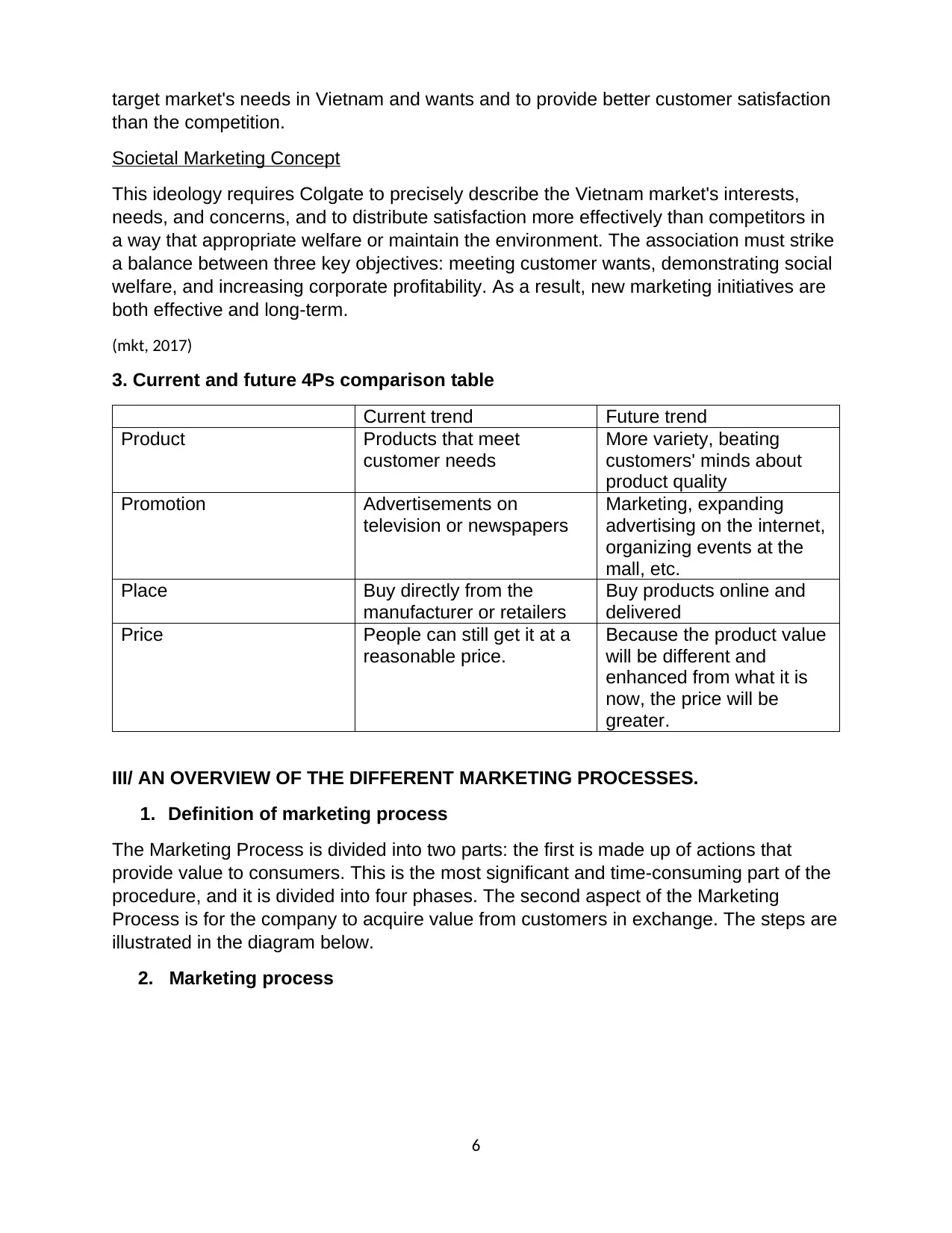
target market's needs in Vietnam and wants and to provide better customer satisfaction
than the competition.
Societal Marketing Concept
This ideology requires Colgate to precisely describe the Vietnam market's interests,
needs, and concerns, and to distribute satisfaction more effectively than competitors in
a way that appropriate welfare or maintain the environment. The association must strike
a balance between three key objectives: meeting customer wants, demonstrating social
welfare, and increasing corporate profitability. As a result, new marketing initiatives are
both effective and long-term.
(mkt, 2017)
3. Current and future 4Ps comparison table
Current trend Future trend
Product Products that meet
customer needs
More variety, beating
customers' minds about
product quality
Promotion Advertisements on
television or newspapers
Marketing, expanding
advertising on the internet,
organizing events at the
mall, etc.
Place Buy directly from the
manufacturer or retailers
Buy products online and
delivered
Price People can still get it at a
reasonable price.
Because the product value
will be different and
enhanced from what it is
now, the price will be
greater.
III/ AN OVERVIEW OF THE DIFFERENT MARKETING PROCESSES.
1. Definition of marketing process
The Marketing Process is divided into two parts: the first is made up of actions that
provide value to consumers. This is the most significant and time-consuming part of the
procedure, and it is divided into four phases. The second aspect of the Marketing
Process is for the company to acquire value from customers in exchange. The steps are
illustrated in the diagram below.
2. Marketing process
6
than the competition.
Societal Marketing Concept
This ideology requires Colgate to precisely describe the Vietnam market's interests,
needs, and concerns, and to distribute satisfaction more effectively than competitors in
a way that appropriate welfare or maintain the environment. The association must strike
a balance between three key objectives: meeting customer wants, demonstrating social
welfare, and increasing corporate profitability. As a result, new marketing initiatives are
both effective and long-term.
(mkt, 2017)
3. Current and future 4Ps comparison table
Current trend Future trend
Product Products that meet
customer needs
More variety, beating
customers' minds about
product quality
Promotion Advertisements on
television or newspapers
Marketing, expanding
advertising on the internet,
organizing events at the
mall, etc.
Place Buy directly from the
manufacturer or retailers
Buy products online and
delivered
Price People can still get it at a
reasonable price.
Because the product value
will be different and
enhanced from what it is
now, the price will be
greater.
III/ AN OVERVIEW OF THE DIFFERENT MARKETING PROCESSES.
1. Definition of marketing process
The Marketing Process is divided into two parts: the first is made up of actions that
provide value to consumers. This is the most significant and time-consuming part of the
procedure, and it is divided into four phases. The second aspect of the Marketing
Process is for the company to acquire value from customers in exchange. The steps are
illustrated in the diagram below.
2. Marketing process
6
⊘ This is a preview!⊘
Do you want full access?
Subscribe today to unlock all pages.

Trusted by 1+ million students worldwide
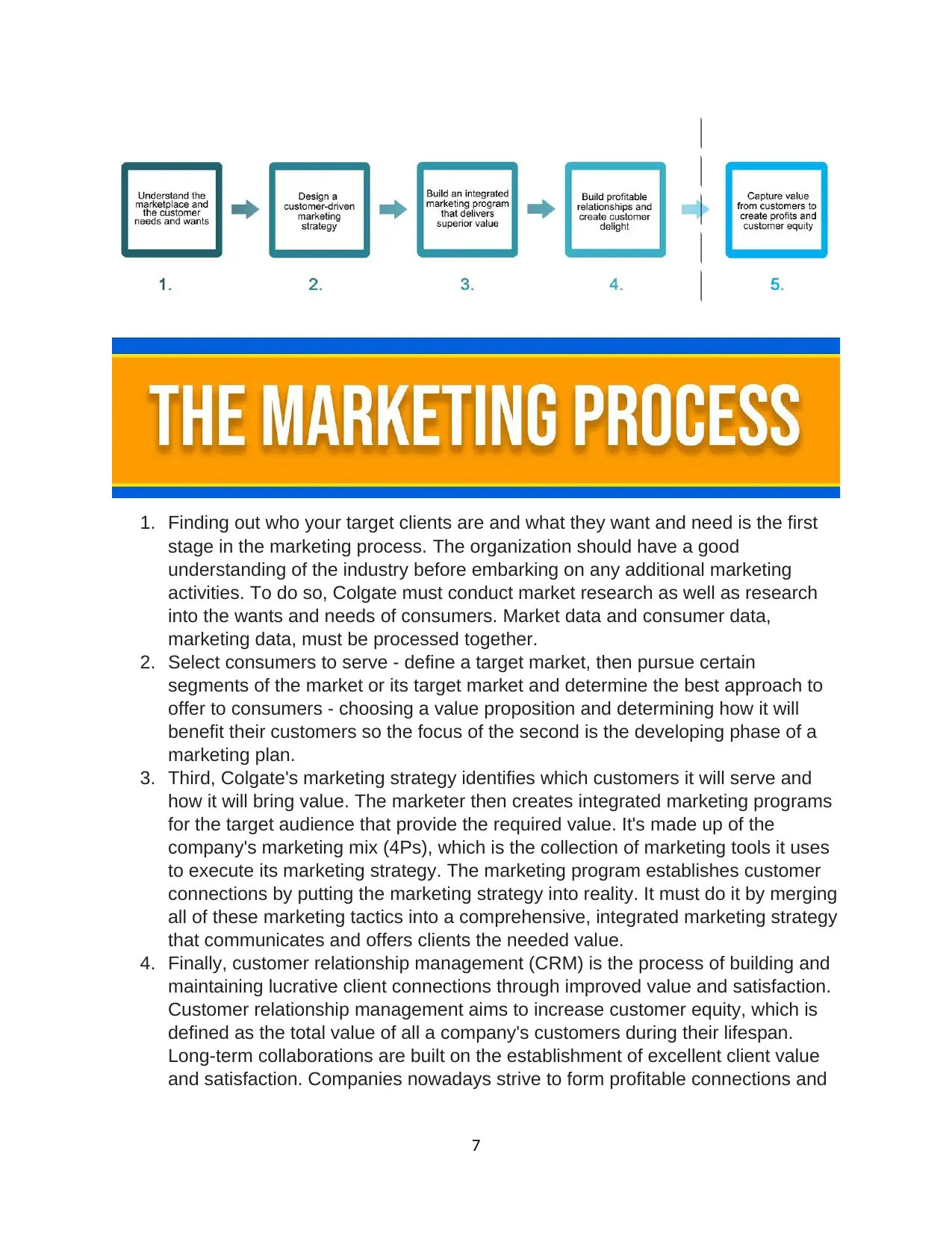
1. Finding out who your target clients are and what they want and need is the first
stage in the marketing process. The organization should have a good
understanding of the industry before embarking on any additional marketing
activities. To do so, Colgate must conduct market research as well as research
into the wants and needs of consumers. Market data and consumer data,
marketing data, must be processed together.
2. Select consumers to serve - define a target market, then pursue certain
segments of the market or its target market and determine the best approach to
offer to consumers - choosing a value proposition and determining how it will
benefit their customers so the focus of the second is the developing phase of a
marketing plan.
3. Third, Colgate's marketing strategy identifies which customers it will serve and
how it will bring value. The marketer then creates integrated marketing programs
for the target audience that provide the required value. It's made up of the
company's marketing mix (4Ps), which is the collection of marketing tools it uses
to execute its marketing strategy. The marketing program establishes customer
connections by putting the marketing strategy into reality. It must do it by merging
all of these marketing tactics into a comprehensive, integrated marketing strategy
that communicates and offers clients the needed value.
4. Finally, customer relationship management (CRM) is the process of building and
maintaining lucrative client connections through improved value and satisfaction.
Customer relationship management aims to increase customer equity, which is
defined as the total value of all a company's customers during their lifespan.
Long-term collaborations are built on the establishment of excellent client value
and satisfaction. Companies nowadays strive to form profitable connections and
7
stage in the marketing process. The organization should have a good
understanding of the industry before embarking on any additional marketing
activities. To do so, Colgate must conduct market research as well as research
into the wants and needs of consumers. Market data and consumer data,
marketing data, must be processed together.
2. Select consumers to serve - define a target market, then pursue certain
segments of the market or its target market and determine the best approach to
offer to consumers - choosing a value proposition and determining how it will
benefit their customers so the focus of the second is the developing phase of a
marketing plan.
3. Third, Colgate's marketing strategy identifies which customers it will serve and
how it will bring value. The marketer then creates integrated marketing programs
for the target audience that provide the required value. It's made up of the
company's marketing mix (4Ps), which is the collection of marketing tools it uses
to execute its marketing strategy. The marketing program establishes customer
connections by putting the marketing strategy into reality. It must do it by merging
all of these marketing tactics into a comprehensive, integrated marketing strategy
that communicates and offers clients the needed value.
4. Finally, customer relationship management (CRM) is the process of building and
maintaining lucrative client connections through improved value and satisfaction.
Customer relationship management aims to increase customer equity, which is
defined as the total value of all a company's customers during their lifespan.
Long-term collaborations are built on the establishment of excellent client value
and satisfaction. Companies nowadays strive to form profitable connections and
7
Paraphrase This Document
Need a fresh take? Get an instant paraphrase of this document with our AI Paraphraser
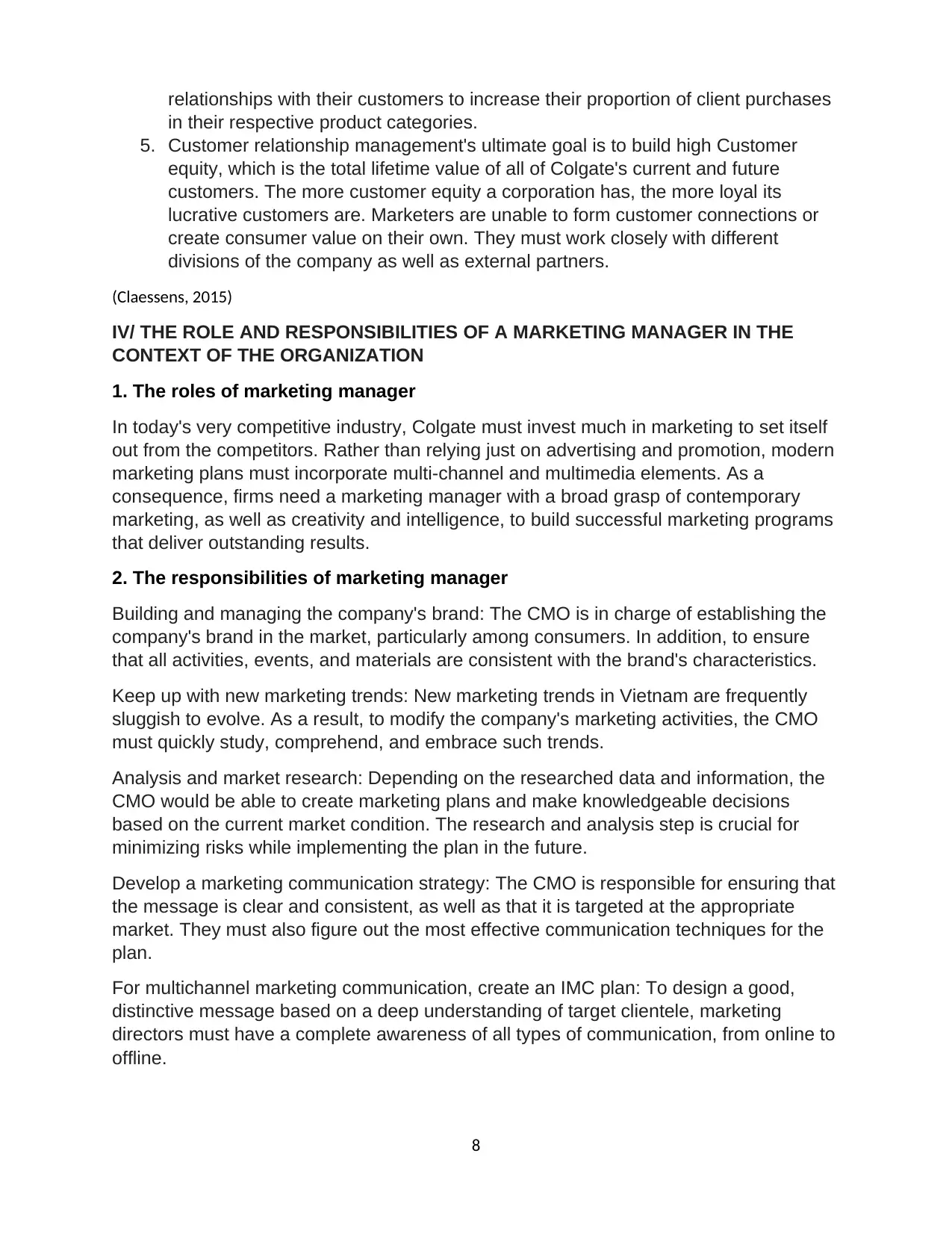
relationships with their customers to increase their proportion of client purchases
in their respective product categories.
5. Customer relationship management's ultimate goal is to build high Customer
equity, which is the total lifetime value of all of Colgate's current and future
customers. The more customer equity a corporation has, the more loyal its
lucrative customers are. Marketers are unable to form customer connections or
create consumer value on their own. They must work closely with different
divisions of the company as well as external partners.
(Claessens, 2015)
IV/ THE ROLE AND RESPONSIBILITIES OF A MARKETING MANAGER IN THE
CONTEXT OF THE ORGANIZATION
1. The roles of marketing manager
In today's very competitive industry, Colgate must invest much in marketing to set itself
out from the competitors. Rather than relying just on advertising and promotion, modern
marketing plans must incorporate multi-channel and multimedia elements. As a
consequence, firms need a marketing manager with a broad grasp of contemporary
marketing, as well as creativity and intelligence, to build successful marketing programs
that deliver outstanding results.
2. The responsibilities of marketing manager
Building and managing the company's brand: The CMO is in charge of establishing the
company's brand in the market, particularly among consumers. In addition, to ensure
that all activities, events, and materials are consistent with the brand's characteristics.
Keep up with new marketing trends: New marketing trends in Vietnam are frequently
sluggish to evolve. As a result, to modify the company's marketing activities, the CMO
must quickly study, comprehend, and embrace such trends.
Analysis and market research: Depending on the researched data and information, the
CMO would be able to create marketing plans and make knowledgeable decisions
based on the current market condition. The research and analysis step is crucial for
minimizing risks while implementing the plan in the future.
Develop a marketing communication strategy: The CMO is responsible for ensuring that
the message is clear and consistent, as well as that it is targeted at the appropriate
market. They must also figure out the most effective communication techniques for the
plan.
For multichannel marketing communication, create an IMC plan: To design a good,
distinctive message based on a deep understanding of target clientele, marketing
directors must have a complete awareness of all types of communication, from online to
offline.
8
in their respective product categories.
5. Customer relationship management's ultimate goal is to build high Customer
equity, which is the total lifetime value of all of Colgate's current and future
customers. The more customer equity a corporation has, the more loyal its
lucrative customers are. Marketers are unable to form customer connections or
create consumer value on their own. They must work closely with different
divisions of the company as well as external partners.
(Claessens, 2015)
IV/ THE ROLE AND RESPONSIBILITIES OF A MARKETING MANAGER IN THE
CONTEXT OF THE ORGANIZATION
1. The roles of marketing manager
In today's very competitive industry, Colgate must invest much in marketing to set itself
out from the competitors. Rather than relying just on advertising and promotion, modern
marketing plans must incorporate multi-channel and multimedia elements. As a
consequence, firms need a marketing manager with a broad grasp of contemporary
marketing, as well as creativity and intelligence, to build successful marketing programs
that deliver outstanding results.
2. The responsibilities of marketing manager
Building and managing the company's brand: The CMO is in charge of establishing the
company's brand in the market, particularly among consumers. In addition, to ensure
that all activities, events, and materials are consistent with the brand's characteristics.
Keep up with new marketing trends: New marketing trends in Vietnam are frequently
sluggish to evolve. As a result, to modify the company's marketing activities, the CMO
must quickly study, comprehend, and embrace such trends.
Analysis and market research: Depending on the researched data and information, the
CMO would be able to create marketing plans and make knowledgeable decisions
based on the current market condition. The research and analysis step is crucial for
minimizing risks while implementing the plan in the future.
Develop a marketing communication strategy: The CMO is responsible for ensuring that
the message is clear and consistent, as well as that it is targeted at the appropriate
market. They must also figure out the most effective communication techniques for the
plan.
For multichannel marketing communication, create an IMC plan: To design a good,
distinctive message based on a deep understanding of target clientele, marketing
directors must have a complete awareness of all types of communication, from online to
offline.
8
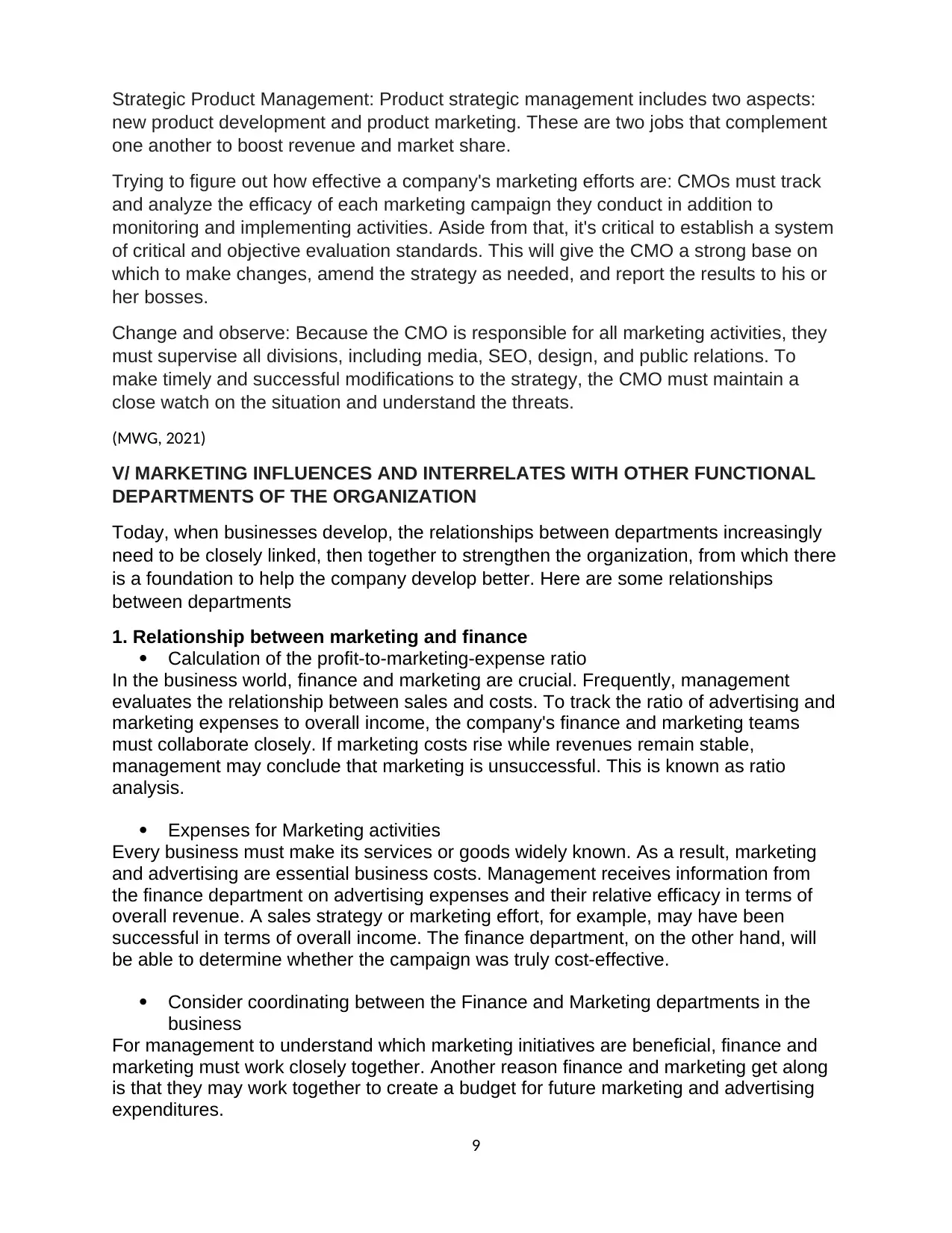
Strategic Product Management: Product strategic management includes two aspects:
new product development and product marketing. These are two jobs that complement
one another to boost revenue and market share.
Trying to figure out how effective a company's marketing efforts are: CMOs must track
and analyze the efficacy of each marketing campaign they conduct in addition to
monitoring and implementing activities. Aside from that, it's critical to establish a system
of critical and objective evaluation standards. This will give the CMO a strong base on
which to make changes, amend the strategy as needed, and report the results to his or
her bosses.
Change and observe: Because the CMO is responsible for all marketing activities, they
must supervise all divisions, including media, SEO, design, and public relations. To
make timely and successful modifications to the strategy, the CMO must maintain a
close watch on the situation and understand the threats.
(MWG, 2021)
V/ MARKETING INFLUENCES AND INTERRELATES WITH OTHER FUNCTIONAL
DEPARTMENTS OF THE ORGANIZATION
Today, when businesses develop, the relationships between departments increasingly
need to be closely linked, then together to strengthen the organization, from which there
is a foundation to help the company develop better. Here are some relationships
between departments
1. Relationship between marketing and finance
Calculation of the profit-to-marketing-expense ratio
In the business world, finance and marketing are crucial. Frequently, management
evaluates the relationship between sales and costs. To track the ratio of advertising and
marketing expenses to overall income, the company's finance and marketing teams
must collaborate closely. If marketing costs rise while revenues remain stable,
management may conclude that marketing is unsuccessful. This is known as ratio
analysis.
Expenses for Marketing activities
Every business must make its services or goods widely known. As a result, marketing
and advertising are essential business costs. Management receives information from
the finance department on advertising expenses and their relative efficacy in terms of
overall revenue. A sales strategy or marketing effort, for example, may have been
successful in terms of overall income. The finance department, on the other hand, will
be able to determine whether the campaign was truly cost-effective.
Consider coordinating between the Finance and Marketing departments in the
business
For management to understand which marketing initiatives are beneficial, finance and
marketing must work closely together. Another reason finance and marketing get along
is that they may work together to create a budget for future marketing and advertising
expenditures.
9
new product development and product marketing. These are two jobs that complement
one another to boost revenue and market share.
Trying to figure out how effective a company's marketing efforts are: CMOs must track
and analyze the efficacy of each marketing campaign they conduct in addition to
monitoring and implementing activities. Aside from that, it's critical to establish a system
of critical and objective evaluation standards. This will give the CMO a strong base on
which to make changes, amend the strategy as needed, and report the results to his or
her bosses.
Change and observe: Because the CMO is responsible for all marketing activities, they
must supervise all divisions, including media, SEO, design, and public relations. To
make timely and successful modifications to the strategy, the CMO must maintain a
close watch on the situation and understand the threats.
(MWG, 2021)
V/ MARKETING INFLUENCES AND INTERRELATES WITH OTHER FUNCTIONAL
DEPARTMENTS OF THE ORGANIZATION
Today, when businesses develop, the relationships between departments increasingly
need to be closely linked, then together to strengthen the organization, from which there
is a foundation to help the company develop better. Here are some relationships
between departments
1. Relationship between marketing and finance
Calculation of the profit-to-marketing-expense ratio
In the business world, finance and marketing are crucial. Frequently, management
evaluates the relationship between sales and costs. To track the ratio of advertising and
marketing expenses to overall income, the company's finance and marketing teams
must collaborate closely. If marketing costs rise while revenues remain stable,
management may conclude that marketing is unsuccessful. This is known as ratio
analysis.
Expenses for Marketing activities
Every business must make its services or goods widely known. As a result, marketing
and advertising are essential business costs. Management receives information from
the finance department on advertising expenses and their relative efficacy in terms of
overall revenue. A sales strategy or marketing effort, for example, may have been
successful in terms of overall income. The finance department, on the other hand, will
be able to determine whether the campaign was truly cost-effective.
Consider coordinating between the Finance and Marketing departments in the
business
For management to understand which marketing initiatives are beneficial, finance and
marketing must work closely together. Another reason finance and marketing get along
is that they may work together to create a budget for future marketing and advertising
expenditures.
9
⊘ This is a preview!⊘
Do you want full access?
Subscribe today to unlock all pages.

Trusted by 1+ million students worldwide
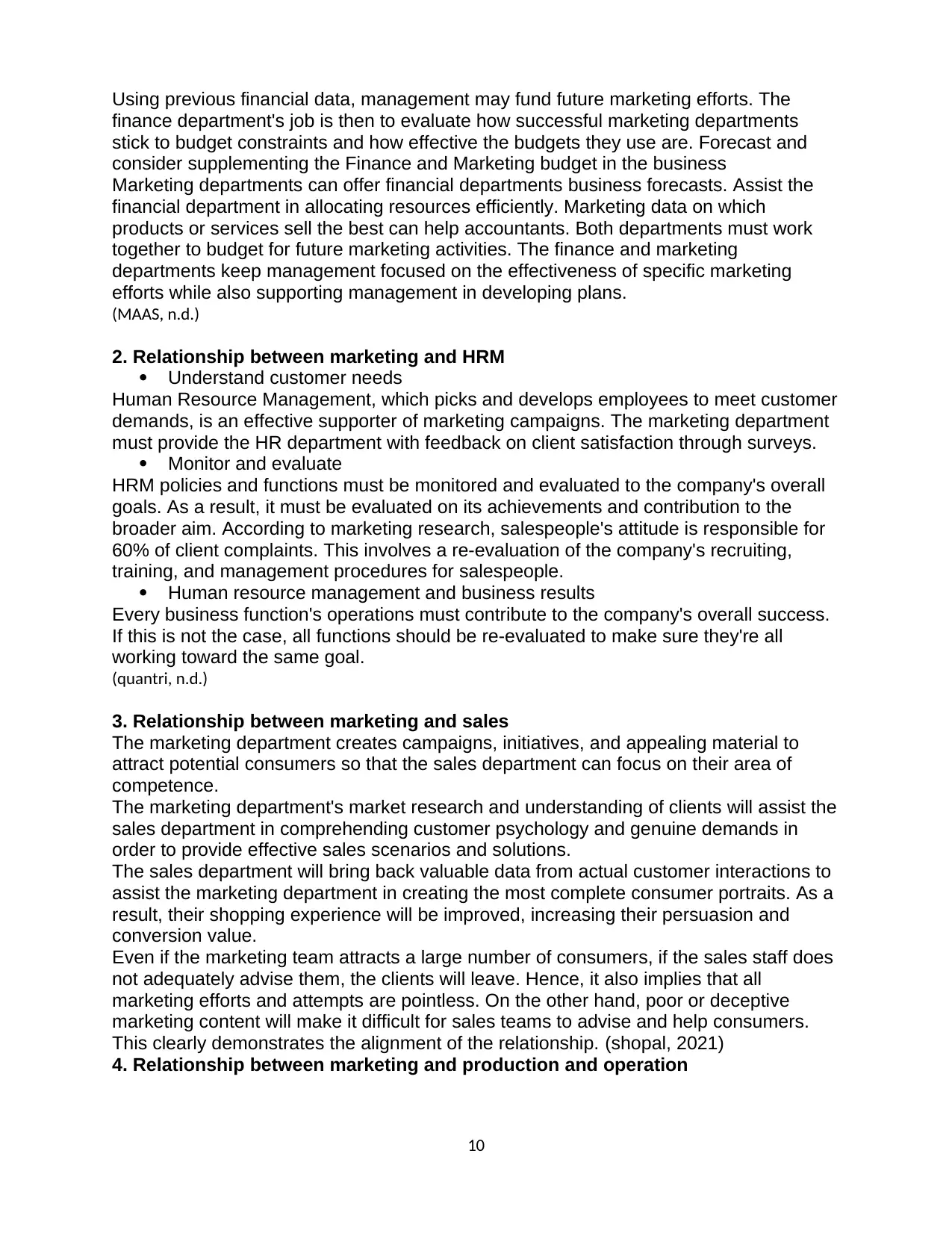
Using previous financial data, management may fund future marketing efforts. The
finance department's job is then to evaluate how successful marketing departments
stick to budget constraints and how effective the budgets they use are. Forecast and
consider supplementing the Finance and Marketing budget in the business
Marketing departments can offer financial departments business forecasts. Assist the
financial department in allocating resources efficiently. Marketing data on which
products or services sell the best can help accountants. Both departments must work
together to budget for future marketing activities. The finance and marketing
departments keep management focused on the effectiveness of specific marketing
efforts while also supporting management in developing plans.
(MAAS, n.d.)
2. Relationship between marketing and HRM
Understand customer needs
Human Resource Management, which picks and develops employees to meet customer
demands, is an effective supporter of marketing campaigns. The marketing department
must provide the HR department with feedback on client satisfaction through surveys.
Monitor and evaluate
HRM policies and functions must be monitored and evaluated to the company's overall
goals. As a result, it must be evaluated on its achievements and contribution to the
broader aim. According to marketing research, salespeople's attitude is responsible for
60% of client complaints. This involves a re-evaluation of the company's recruiting,
training, and management procedures for salespeople.
Human resource management and business results
Every business function's operations must contribute to the company's overall success.
If this is not the case, all functions should be re-evaluated to make sure they're all
working toward the same goal.
(quantri, n.d.)
3. Relationship between marketing and sales
The marketing department creates campaigns, initiatives, and appealing material to
attract potential consumers so that the sales department can focus on their area of
competence.
The marketing department's market research and understanding of clients will assist the
sales department in comprehending customer psychology and genuine demands in
order to provide effective sales scenarios and solutions.
The sales department will bring back valuable data from actual customer interactions to
assist the marketing department in creating the most complete consumer portraits. As a
result, their shopping experience will be improved, increasing their persuasion and
conversion value.
Even if the marketing team attracts a large number of consumers, if the sales staff does
not adequately advise them, the clients will leave. Hence, it also implies that all
marketing efforts and attempts are pointless. On the other hand, poor or deceptive
marketing content will make it difficult for sales teams to advise and help consumers.
This clearly demonstrates the alignment of the relationship. (shopal, 2021)
4. Relationship between marketing and production and operation
10
finance department's job is then to evaluate how successful marketing departments
stick to budget constraints and how effective the budgets they use are. Forecast and
consider supplementing the Finance and Marketing budget in the business
Marketing departments can offer financial departments business forecasts. Assist the
financial department in allocating resources efficiently. Marketing data on which
products or services sell the best can help accountants. Both departments must work
together to budget for future marketing activities. The finance and marketing
departments keep management focused on the effectiveness of specific marketing
efforts while also supporting management in developing plans.
(MAAS, n.d.)
2. Relationship between marketing and HRM
Understand customer needs
Human Resource Management, which picks and develops employees to meet customer
demands, is an effective supporter of marketing campaigns. The marketing department
must provide the HR department with feedback on client satisfaction through surveys.
Monitor and evaluate
HRM policies and functions must be monitored and evaluated to the company's overall
goals. As a result, it must be evaluated on its achievements and contribution to the
broader aim. According to marketing research, salespeople's attitude is responsible for
60% of client complaints. This involves a re-evaluation of the company's recruiting,
training, and management procedures for salespeople.
Human resource management and business results
Every business function's operations must contribute to the company's overall success.
If this is not the case, all functions should be re-evaluated to make sure they're all
working toward the same goal.
(quantri, n.d.)
3. Relationship between marketing and sales
The marketing department creates campaigns, initiatives, and appealing material to
attract potential consumers so that the sales department can focus on their area of
competence.
The marketing department's market research and understanding of clients will assist the
sales department in comprehending customer psychology and genuine demands in
order to provide effective sales scenarios and solutions.
The sales department will bring back valuable data from actual customer interactions to
assist the marketing department in creating the most complete consumer portraits. As a
result, their shopping experience will be improved, increasing their persuasion and
conversion value.
Even if the marketing team attracts a large number of consumers, if the sales staff does
not adequately advise them, the clients will leave. Hence, it also implies that all
marketing efforts and attempts are pointless. On the other hand, poor or deceptive
marketing content will make it difficult for sales teams to advise and help consumers.
This clearly demonstrates the alignment of the relationship. (shopal, 2021)
4. Relationship between marketing and production and operation
10
Paraphrase This Document
Need a fresh take? Get an instant paraphrase of this document with our AI Paraphraser
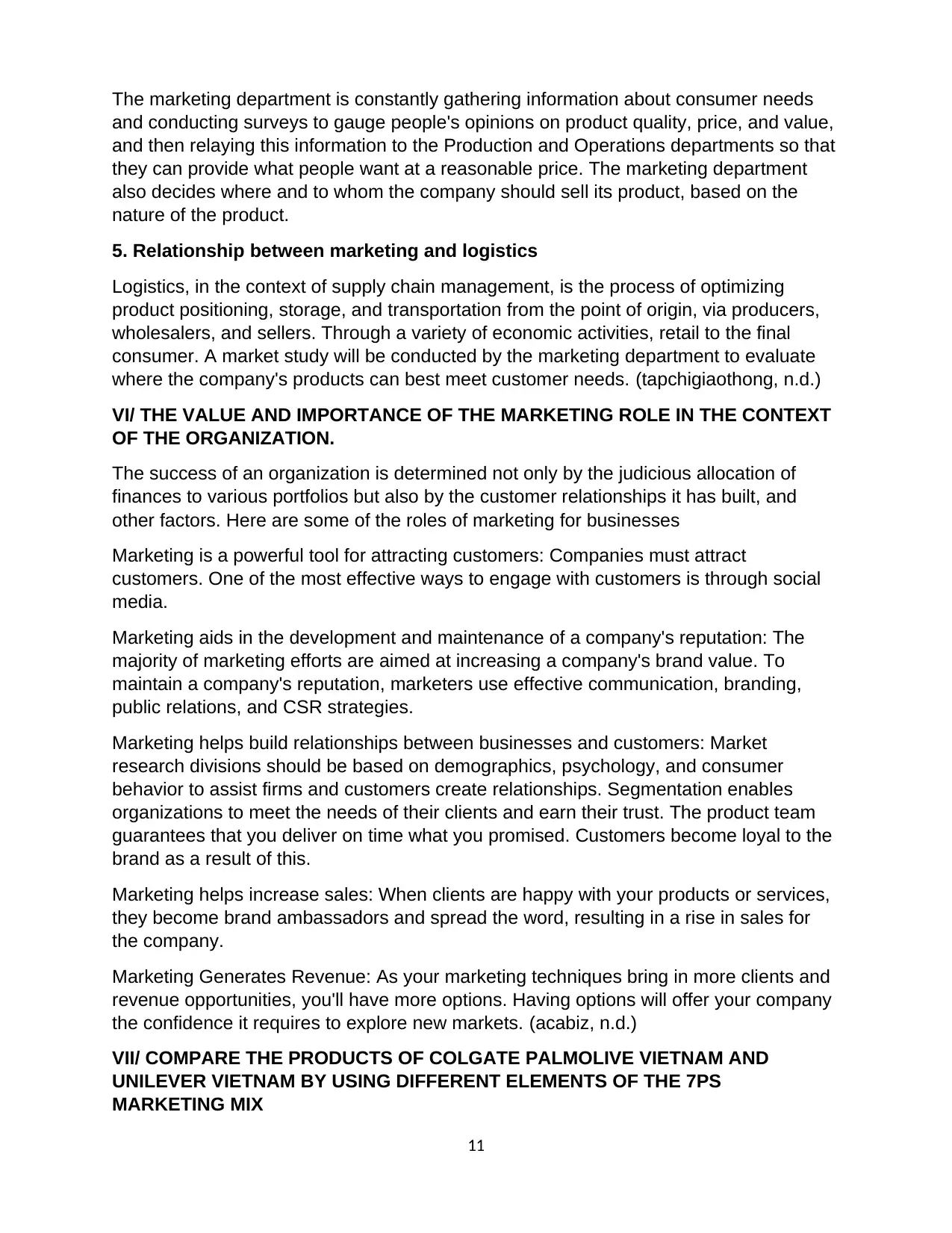
The marketing department is constantly gathering information about consumer needs
and conducting surveys to gauge people's opinions on product quality, price, and value,
and then relaying this information to the Production and Operations departments so that
they can provide what people want at a reasonable price. The marketing department
also decides where and to whom the company should sell its product, based on the
nature of the product.
5. Relationship between marketing and logistics
Logistics, in the context of supply chain management, is the process of optimizing
product positioning, storage, and transportation from the point of origin, via producers,
wholesalers, and sellers. Through a variety of economic activities, retail to the final
consumer. A market study will be conducted by the marketing department to evaluate
where the company's products can best meet customer needs. (tapchigiaothong, n.d.)
VI/ THE VALUE AND IMPORTANCE OF THE MARKETING ROLE IN THE CONTEXT
OF THE ORGANIZATION.
The success of an organization is determined not only by the judicious allocation of
finances to various portfolios but also by the customer relationships it has built, and
other factors. Here are some of the roles of marketing for businesses
Marketing is a powerful tool for attracting customers: Companies must attract
customers. One of the most effective ways to engage with customers is through social
media.
Marketing aids in the development and maintenance of a company's reputation: The
majority of marketing efforts are aimed at increasing a company's brand value. To
maintain a company's reputation, marketers use effective communication, branding,
public relations, and CSR strategies.
Marketing helps build relationships between businesses and customers: Market
research divisions should be based on demographics, psychology, and consumer
behavior to assist firms and customers create relationships. Segmentation enables
organizations to meet the needs of their clients and earn their trust. The product team
guarantees that you deliver on time what you promised. Customers become loyal to the
brand as a result of this.
Marketing helps increase sales: When clients are happy with your products or services,
they become brand ambassadors and spread the word, resulting in a rise in sales for
the company.
Marketing Generates Revenue: As your marketing techniques bring in more clients and
revenue opportunities, you'll have more options. Having options will offer your company
the confidence it requires to explore new markets. (acabiz, n.d.)
VII/ COMPARE THE PRODUCTS OF COLGATE PALMOLIVE VIETNAM AND
UNILEVER VIETNAM BY USING DIFFERENT ELEMENTS OF THE 7PS
MARKETING MIX
11
and conducting surveys to gauge people's opinions on product quality, price, and value,
and then relaying this information to the Production and Operations departments so that
they can provide what people want at a reasonable price. The marketing department
also decides where and to whom the company should sell its product, based on the
nature of the product.
5. Relationship between marketing and logistics
Logistics, in the context of supply chain management, is the process of optimizing
product positioning, storage, and transportation from the point of origin, via producers,
wholesalers, and sellers. Through a variety of economic activities, retail to the final
consumer. A market study will be conducted by the marketing department to evaluate
where the company's products can best meet customer needs. (tapchigiaothong, n.d.)
VI/ THE VALUE AND IMPORTANCE OF THE MARKETING ROLE IN THE CONTEXT
OF THE ORGANIZATION.
The success of an organization is determined not only by the judicious allocation of
finances to various portfolios but also by the customer relationships it has built, and
other factors. Here are some of the roles of marketing for businesses
Marketing is a powerful tool for attracting customers: Companies must attract
customers. One of the most effective ways to engage with customers is through social
media.
Marketing aids in the development and maintenance of a company's reputation: The
majority of marketing efforts are aimed at increasing a company's brand value. To
maintain a company's reputation, marketers use effective communication, branding,
public relations, and CSR strategies.
Marketing helps build relationships between businesses and customers: Market
research divisions should be based on demographics, psychology, and consumer
behavior to assist firms and customers create relationships. Segmentation enables
organizations to meet the needs of their clients and earn their trust. The product team
guarantees that you deliver on time what you promised. Customers become loyal to the
brand as a result of this.
Marketing helps increase sales: When clients are happy with your products or services,
they become brand ambassadors and spread the word, resulting in a rise in sales for
the company.
Marketing Generates Revenue: As your marketing techniques bring in more clients and
revenue opportunities, you'll have more options. Having options will offer your company
the confidence it requires to explore new markets. (acabiz, n.d.)
VII/ COMPARE THE PRODUCTS OF COLGATE PALMOLIVE VIETNAM AND
UNILEVER VIETNAM BY USING DIFFERENT ELEMENTS OF THE 7PS
MARKETING MIX
11
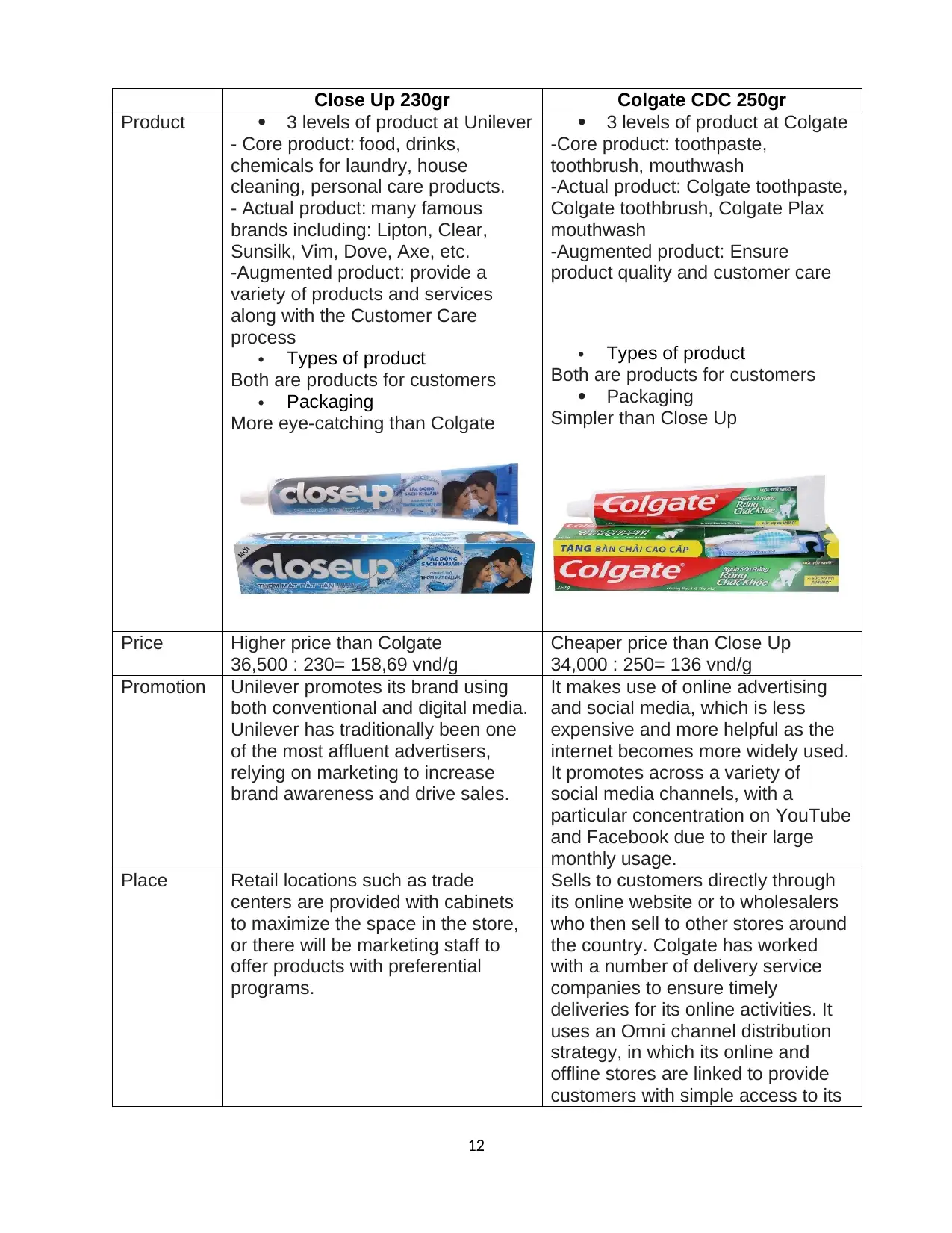
Close Up 230gr Colgate CDC 250gr
Product 3 levels of product at Unilever
- Core product: food, drinks,
chemicals for laundry, house
cleaning, personal care products.
- Actual product: many famous
brands including: Lipton, Clear,
Sunsilk, Vim, Dove, Axe, etc.
-Augmented product: provide a
variety of products and services
along with the Customer Care
process
Types of product
Both are products for customers
Packaging
More eye-catching than Colgate
3 levels of product at Colgate
-Core product: toothpaste,
toothbrush, mouthwash
-Actual product: Colgate toothpaste,
Colgate toothbrush, Colgate Plax
mouthwash
-Augmented product: Ensure
product quality and customer care
Types of product
Both are products for customers
Packaging
Simpler than Close Up
Price Higher price than Colgate
36,500 : 230= 158,69 vnd/g
Cheaper price than Close Up
34,000 : 250= 136 vnd/g
Promotion Unilever promotes its brand using
both conventional and digital media.
Unilever has traditionally been one
of the most affluent advertisers,
relying on marketing to increase
brand awareness and drive sales.
It makes use of online advertising
and social media, which is less
expensive and more helpful as the
internet becomes more widely used.
It promotes across a variety of
social media channels, with a
particular concentration on YouTube
and Facebook due to their large
monthly usage.
Place Retail locations such as trade
centers are provided with cabinets
to maximize the space in the store,
or there will be marketing staff to
offer products with preferential
programs.
Sells to customers directly through
its online website or to wholesalers
who then sell to other stores around
the country. Colgate has worked
with a number of delivery service
companies to ensure timely
deliveries for its online activities. It
uses an Omni channel distribution
strategy, in which its online and
offline stores are linked to provide
customers with simple access to its
12
Product 3 levels of product at Unilever
- Core product: food, drinks,
chemicals for laundry, house
cleaning, personal care products.
- Actual product: many famous
brands including: Lipton, Clear,
Sunsilk, Vim, Dove, Axe, etc.
-Augmented product: provide a
variety of products and services
along with the Customer Care
process
Types of product
Both are products for customers
Packaging
More eye-catching than Colgate
3 levels of product at Colgate
-Core product: toothpaste,
toothbrush, mouthwash
-Actual product: Colgate toothpaste,
Colgate toothbrush, Colgate Plax
mouthwash
-Augmented product: Ensure
product quality and customer care
Types of product
Both are products for customers
Packaging
Simpler than Close Up
Price Higher price than Colgate
36,500 : 230= 158,69 vnd/g
Cheaper price than Close Up
34,000 : 250= 136 vnd/g
Promotion Unilever promotes its brand using
both conventional and digital media.
Unilever has traditionally been one
of the most affluent advertisers,
relying on marketing to increase
brand awareness and drive sales.
It makes use of online advertising
and social media, which is less
expensive and more helpful as the
internet becomes more widely used.
It promotes across a variety of
social media channels, with a
particular concentration on YouTube
and Facebook due to their large
monthly usage.
Place Retail locations such as trade
centers are provided with cabinets
to maximize the space in the store,
or there will be marketing staff to
offer products with preferential
programs.
Sells to customers directly through
its online website or to wholesalers
who then sell to other stores around
the country. Colgate has worked
with a number of delivery service
companies to ensure timely
deliveries for its online activities. It
uses an Omni channel distribution
strategy, in which its online and
offline stores are linked to provide
customers with simple access to its
12
⊘ This is a preview!⊘
Do you want full access?
Subscribe today to unlock all pages.

Trusted by 1+ million students worldwide
1 out of 16
Related Documents
Your All-in-One AI-Powered Toolkit for Academic Success.
+13062052269
info@desklib.com
Available 24*7 on WhatsApp / Email
![[object Object]](/_next/static/media/star-bottom.7253800d.svg)
Unlock your academic potential
Copyright © 2020–2025 A2Z Services. All Rights Reserved. Developed and managed by ZUCOL.





